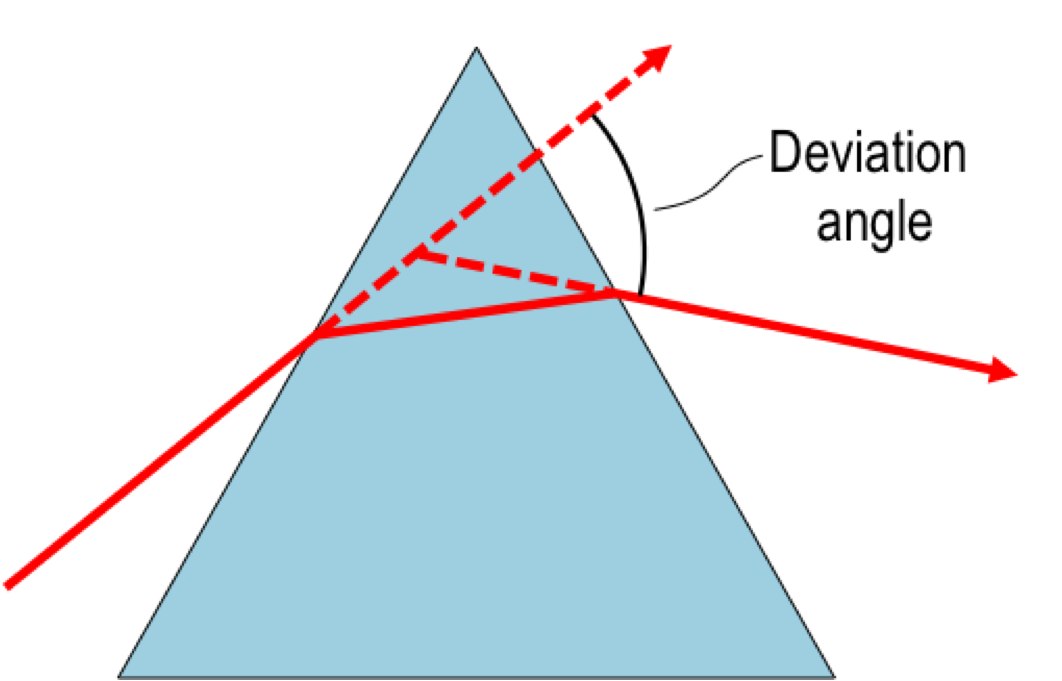
In the case of minimum deviation position the, a ray travels within the prism:
a. Symmetrically
b. Asymmetrically
c. Normally
d. Transversally
Answer
553.2k+ views
Hint: We can compare the incidence angle and the emergence angle. With the help of these two values we are able to find the answer to the given question.
Formula used:
$i = e$
Where $i$ is the angle of incidence and $e$ is the angle of emergence.
Complete step by step answer:
To answer the given question, first we need to understand the basic angles of the prism.
Consider a prism. We know that a prism has angles. When a ray that is incident on a surface of a prism is known as Incident ray. The angle between that incident ray and the line that is normal to that particular surface is known as Angle of Incidence.
A ray of light that is bent at a particular point of the prism is known as the Angle of Deviation. Always remember that the angle of deviation decreases with the increase in the angle of incidence. This angle of incidence in a prism where the angle of the deviation is minimum is called the Angle of Minimum Deviation.
The angle of the light that comes out through the medium of the prism is known as the Emergence angle.
Consider the minimum deviation position of the prism. When the angle of the incidence at one surface of the prism and the angle of emergence angle at another surface of the prism, the light rays inside the prism travel parallel to the base. In other words, we can say that the light rays will move symmetrically inside the prism.
The angle of incidence and the angle of emergence are always equal. We can represent this relation mathematically as,
$ \Rightarrow i = e$
Where $i$ is the angle of incidence and $e$ is the angle of emergence

Consider the given diagram of the prism. From the diagram it is clear that the light ray that travels inside the prism is symmetrical to the base.
Therefore, in the case of the minimum deviation position the ray travels symmetrically within the prism.
Hence, the correct answer is option (A).
Note: The formula for the minimum deviation can be derived by changing some terms in the Snell’s law. Mathematically it can be represented as,
$ \Rightarrow n = \dfrac{{\sin \left( {\dfrac{{A + {D_m}}}{2}} \right)}}{{\sin \left( {\dfrac{A}{2}} \right)}}$
Where $A$ is the angle of prism and ${D_m}$ is the angle of minimum deviation.
Formula used:
$i = e$
Where $i$ is the angle of incidence and $e$ is the angle of emergence.
Complete step by step answer:
To answer the given question, first we need to understand the basic angles of the prism.
Consider a prism. We know that a prism has angles. When a ray that is incident on a surface of a prism is known as Incident ray. The angle between that incident ray and the line that is normal to that particular surface is known as Angle of Incidence.
A ray of light that is bent at a particular point of the prism is known as the Angle of Deviation. Always remember that the angle of deviation decreases with the increase in the angle of incidence. This angle of incidence in a prism where the angle of the deviation is minimum is called the Angle of Minimum Deviation.
The angle of the light that comes out through the medium of the prism is known as the Emergence angle.
Consider the minimum deviation position of the prism. When the angle of the incidence at one surface of the prism and the angle of emergence angle at another surface of the prism, the light rays inside the prism travel parallel to the base. In other words, we can say that the light rays will move symmetrically inside the prism.
The angle of incidence and the angle of emergence are always equal. We can represent this relation mathematically as,
$ \Rightarrow i = e$
Where $i$ is the angle of incidence and $e$ is the angle of emergence

Consider the given diagram of the prism. From the diagram it is clear that the light ray that travels inside the prism is symmetrical to the base.
Therefore, in the case of the minimum deviation position the ray travels symmetrically within the prism.
Hence, the correct answer is option (A).
Note: The formula for the minimum deviation can be derived by changing some terms in the Snell’s law. Mathematically it can be represented as,
$ \Rightarrow n = \dfrac{{\sin \left( {\dfrac{{A + {D_m}}}{2}} \right)}}{{\sin \left( {\dfrac{A}{2}} \right)}}$
Where $A$ is the angle of prism and ${D_m}$ is the angle of minimum deviation.
Recently Updated Pages
Master Class 12 Business Studies: Engaging Questions & Answers for Success

Master Class 12 Economics: Engaging Questions & Answers for Success

Master Class 12 English: Engaging Questions & Answers for Success

Master Class 12 Maths: Engaging Questions & Answers for Success

Master Class 12 Social Science: Engaging Questions & Answers for Success

Master Class 12 Chemistry: Engaging Questions & Answers for Success

Trending doubts
What are the major means of transport Explain each class 12 social science CBSE

Which are the Top 10 Largest Countries of the World?

Draw a labelled sketch of the human eye class 12 physics CBSE

How much time does it take to bleed after eating p class 12 biology CBSE

Explain sex determination in humans with line diag class 12 biology CBSE

Differentiate between homogeneous and heterogeneous class 12 chemistry CBSE




